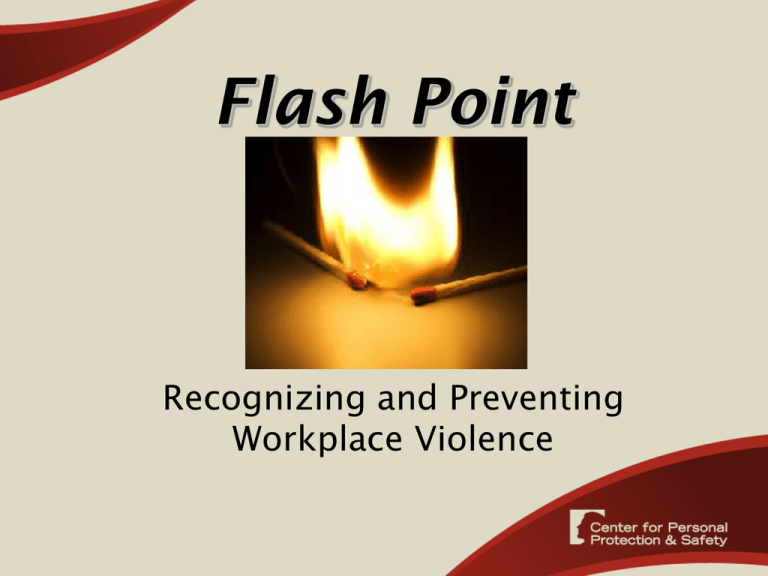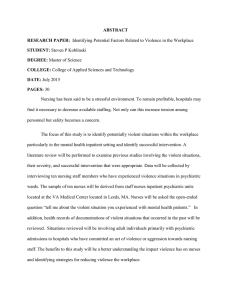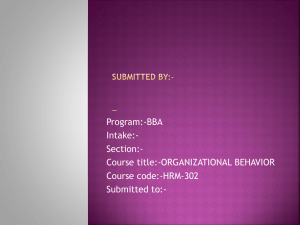Flash Point Recognizing and Preventing Workplace Violence
advertisement

Flash Point Recognizing and Preventing Workplace Violence Workplace Violence Behaviors that can cause: Personal injury Damage property Impede the normal course of work Cause workers/managers/ customers to fear for their safety Workplace Violence (cont’d) Include: Threats Stalking Harassment Domestic Violence Intimidation Workplace Homicides Bullying Merely represent the “tip of the iceberg” Workplace Violence Four broad categories: TYPE 1: Violent acts by criminals who have no other connection with the workplace, but enter to commit robbery or another crime TYPE 2: Violence directed at employees by customers, clients, patients, students, or others to whom service is provided TYPE 3: Violence against coworkers, supervisors, or managers by a present or former employee TYPE 4: Violence committed in the workplace by someone who doesn’t work there, but has a personal relationship with an employee—an abusive spouse or domestic partner Myths “Out of the blue...” “Just snapped...” “If left alone, events will resolve themselves...” “Employees can’t do anything to stop it...” It couldn’t happen here...” Workplace Violence Spectrum May not be a linear progression To the right are acts of overt violence causing physical injury and/or death Moving to the left are psychological and emotional violence To the far left are Behaviors of Concern No profile of a workplace violence offender Behaviors of Concern There are behaviors that suggest the potential for future violence If there’s a behavior that makes you uncomfortable, it’s best to listen to what may be an intuitive warning If you see something or sense something, say something May be an innocent explanation for behavior if left unaddressed, could escalate and contribute to a toxic work environment Behaviors of Concern The following may alert supervisors to potential problems Threats, frequent aggressive outbursts, or excessive displays of temper History of threats/violent acts Ominous fascination with weapons and/or references to weapons, violent media content, or violent events Behaviors of Concern (cont’d) Verbal abuse of co-workers and customers, or harassment through phone calls or emails Bizarre comments or behavior, including violent content Holding grudges, inability to handle criticism, making excuses, and blaming others Chronic, hypersensitive complaints about persecution Making jokes or offensive comments about violent acts Behaviors of Concern Do not focus on “snapshots” No one behavior suggests a greater level of threat; significant changes in patterns of behavior are far more telling Employee is sending out a personal “SOS” distress signal Learn to recognize the signals that could point in the direction of violence and then learn to respond to them Behaviors of Concern Minor non-violent conflicts that went unresolved built up until they were no longer manageable When people go into a crisis state, it affects the way they think, feel, and behave intervening early in a conflict may result in a resolution before the problem gets out of control Frequency, duration, and intensity are critical criteria when evaluating Behaviors of Concern Behaviors of Concern - Domestic Abuse - Employees may observe behaviors which might suggest violence at home Disruptive phone calls and emails at work Discomfort when communicating with others Anxiety and lack of concentration on the job Unexplained bruises or injuries Inappropriate clothing for the time of year Frequent work absences Unplanned use of personal time Disruptive visits to the workplace by a current or former intimate partner Workplace Violence Formula Awareness + Action = Prevention You can do something about many situations Action has to be appropriate Without awareness and willingness to act, you truly become vulnerable Flash Point The point on the Workplace Violence Spectrum where actual violence occurs Exact location can vary from one situation and individual to another Different actions in the work environment can trigger or cause a Flash Point May be the result of non-work related situations Domestic Violence Other Personal Issues Action Point Recognition that violence may be an outcome; respond with an appropriate action Important to exercise caution when setting an early Action Point Important not to delay reporting a threat Better chance of containing a potentially violent event Minimize harmful consequences and prevent a recurrence Stress tolerance and coping skills are highly subjective Common Inhibitors Lack of awareness Psychological barriers Not trained to recognize Behaviors of Concern Busybody or snitch Fear of retaliation Believe it is someone else’s responsibility If a flash point is triggered, it will affect you Reporting Options For lower level behaviors, might feel comfortable giving person a chance to talk or vent Report behavior to person in authority Supervisor, Human Resources, Security, Employee Assistance 24/7 Tip Lines Suggestion Box, Emails, Texting Ombudsman Ethics Hotline Strength in numbers; team up Summary Work from a mindset of awareness Don’t ignore Behaviors of Concern Will not go away and can escalate Learn how to recognize and diffuse potentially violent situations Alert supervisors to concerns Report all incidents






